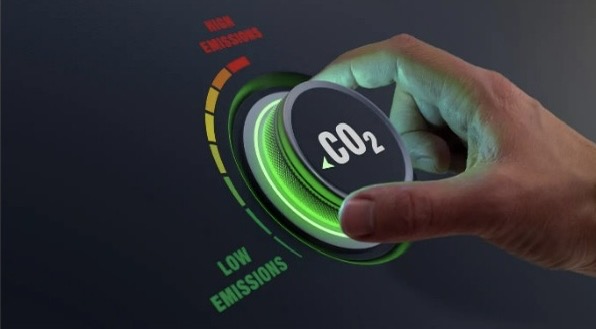A Milestone in Sustainable Development 可持续发展的里程碑
China recently issued its first zero-carbon energy consumption certificate, marking a significant step toward promoting market-driven green value for renewable energy, particularly in non-electrical applications like biomass. This certificate, priced at 60 yuan (around 8.40 US$), was facilitated by the Zero Carbon Energy Certification platform and underscores China’s commitment to its carbon neutrality goals. The initiative sets a precedent for verifying, trading, and pricing zero-carbon energy, aligning with national carbon trading standards.
The Zero Carbon Energy Certification platform, established in December 2023, completed the entire process, including certificate application, monitoring, verification, issuance and trade.
中国最近颁发了首张零碳能源消费证书,标志着推动市场化绿色价值的一个重要步骤,尤其是在生物质等非电力应用领域。该证书价格为60元人民币(约8.40美元),由零碳能源认证平台促成,彰显了中国对实现碳中和目标的承诺。这一举措为零碳能源的验证、交易和定价树立了先例,并与国家碳交易标准相一致。
零碳能源认证平台于2023年12月成立,完成了整个过程,包括证书申请、监测、验证、颁发和交易。
The certificate’s launch signals greater incentives for industries to invest in sustainable energy solutions, as the price mechanism is tied to market dynamics, reflecting supply and demand. It also represents a broader shift toward market-based environmental policies, where companies are rewarded for adopting green technologies. For more details, read the full article at China Daily.
This innovative approach is expected to inspire further development of similar certificates across various renewable sectors, driving China’s transition to a low-carbon economy.
China’s first zero-carbon energy consumption certificate marks a critical step in building a more robust and market-driven carbon economy. This initiative introduces a system where renewable energy can be certified, priced, and traded, supporting China’s ambitions to peak carbon emissions by 2030 and reach neutrality by 2060.
该证书的发布为企业投资于可持续能源解决方案提供了更大的激励,因为其定价机制与市场动态挂钩,反映了供需关系。这也代表着向基于市场的环保政策的更广泛转变,企业因采用绿色技术而受益。更多详细信息,请参阅《中国日报》的完整文章。
这一创新举措有望激励各类可再生能源领域的类似证书发展,推动中国向低碳经济的转型。
中国首张零碳能源消费证书标志着建立更具市场驱动性的碳经济的重要一步。该举措引入了一种可再生能源可以认证、定价和交易的系统,支持中国到2030年实现碳排放达峰,并于2060年实现碳中和的目标。
1. Next Steps for China’s Carbon Market Expansion
The launch of China’s zero-carbon certificate represents the beginning of a larger movement towards formalized carbon markets across various sectors. While the certificate initially focuses on biomass, policymakers are expected to expand its scope to cover additional renewable energy sources such as wind, solar, and hydropower.
Integrating this certification into China’s national carbon trading system could allow companies to directly offset their carbon footprint through certified clean energy purchases, thereby increasing market participation and accelerating investment in green energy.
China is set to expand and refine both its compliance and voluntary carbon markets. The National Emissions Trading System (ETS), which started with the power sector, is now expanding to other high-emission industries like cement, steel, and aluminum.
1. 中国碳市场扩展的下一步
中国零碳证书的推出是推动各领域正式碳市场发展的起点。尽管该证书初步聚焦于生物质,政策制定者预计会将其覆盖范围扩展至风能、太阳能和水电等其他可再生能源。
将此认证纳入中国的国家碳交易体系,可使企业通过购买认证的清洁能源来直接抵消其碳足迹,从而增加市场参与度并加速绿色能源投资。
中国将扩展并完善其合规和自愿碳市场。自电力行业启动以来,国家碳排放交易系统(ETS)现已扩展至水泥、钢铁和铝等高排放行业。
This expansion aligns with China’s strategy to include emissions-intensive industries under its ETS to meet the dual goals of peaking emissions by 2030 and achieving neutrality by 2060.
Additionally, a re-launch of the China Certified Emission Reduction (CCER) system, which paused in 2017, is expected to drive growth in the voluntary market by enabling new project types such as offshore wind and forestry to generate tradable carbon credits.
Another next step is the integration of green and low-carbon futures trading. The Guangzhou Futures Exchange plans to introduce low-carbon financial products, while cities like Shanghai and Hubei are building infrastructure to support carbon trading for derivatives and spot markets. This evolving market infrastructure could soon allow Hong Kong and Mainland China to interconnect carbon markets, enabling cross-border investments.
这一扩展符合中国将高排放行业纳入ETS的战略,以实现2030年碳达峰和2060年碳中和的双重目标。
此外,预计在2017年暂停的中国核证减排量(CCER)系统将重新启动,以推动自愿市场的增长,使海上风电和林业等新项目类型能够生成可交易的碳信用。
另一个下一步是绿色和低碳期货交易的整合。广州期货交易所计划推出低碳金融产品,而上海和湖北等城市正在建设支持衍生品和现货市场碳交易的基础设施。这一不断发展的市场基础设施可能很快允许香港和中国内地互联碳市场,从而实现跨境投资。
2. Key Players in the Carbon Market
The main players shaping China’s carbon market include:
– Government Agencies:
The Ministry of Ecology and Environment (MEE) oversees both compliance and voluntary carbon markets. It recently introduced stricter trading rules and methodologies for carbon emissions reduction projects, setting a legal basis for CCER projects and facilitating the registration and verification processes.
– Energy Producers:
Renewable energy providers are expected to benefit from the certification of zero-carbon energy. By monetizing clean energy output through certifications, these companies can drive revenue while contributing to national decarbonization efforts.
– Financial Institutions and Technology Institutions:
Banks and securities firms, such as eight Chinese securities companies now authorized to trade in carbon credits, play a growing role in carbon financing. Financial entities like the Shanghai Clearing House and Hubei Carbon Exchange are pioneering clearing services for carbon-related trades, providing transparency and liquidity to the market.
Blockchain and digital platforms are instrumental in the verification, issuance, and trade of carbon credits, ensuring integrity and traceability in all transactions.
– Industrial Sectors:
High-emission sectors, particularly power generation, cement, and metallurgy, are becoming primary participants as new ETS phases bring them into compliance with carbon emission limits. These sectors will need to purchase emission allowances or credits to offset their carbon output, driving demand within the carbon market.
2. 碳市场的主要参与者
塑造中国碳市场的主要参与者包括:
– 政府机构:
生态环境部(MEE)监督合规和自愿碳市场。该部门最近引入了更严格的交易规则和减排项目的方法学,为CCER项目提供法律基础,并简化了注册和验证流程。
– 能源生产商:
可再生能源供应商预计将从零碳能源认证中受益。通过认证实现清洁能源产出的货币化,这些公司能够增加收入,同时为国家脱碳做出贡献。
– 金融机构和技术机构:
银行和证券公司(如八家获授权进行碳信用交易的中国证券公司)在碳融资中发挥着越来越大的作用。上海清算所和湖北碳交易所等金融机构正在开创碳相关交易的清算服务,为市场提供透明度和流动性。
区块链和数字平台在碳信用的验证、发行和交易中发挥重要作用,确保所有交易的完整性和可追溯性。
– 工业部门:
高排放行业,尤其是发电、水泥和冶金行业,正成为新的ETS阶段的主要参与者,遵守碳排放限制。这些行业需要购买排放配额或信用以抵消其碳排放,推动了碳市场的需求。

3. Projected Outcomes of a Developed Carbon Market in China
The ongoing expansion of China’s carbon market, combined with the introduction of zero-carbon certificates, could yield numerous economic and environmental benefits:
– Boosting Green Investments:
As the certification and carbon market systems mature, renewable energy providers are likely to see increased investments. Attaching financial value to emissions reductions provides companies with a strong business case for adopting energy-efficient processes and sustainable practices. This shift is expected to attract capital for green projects, stimulating innovations in low-carbon solutions.
– Corporate Accountability and Competitiveness:
As global markets increasingly favor environmentally responsible businesses, zero-carbon certificates enable Chinese companies to enhance their brand reputation and attract sustainable investments. By participating in the carbon market, companies demonstrate their commitment to environmental accountability, keeping them competitive on an international scale as demand grows for carbon-neutral suppliers.
– Efficient Carbon Pricing Mechanism:
Allowing the market to determine certificate prices based on supply and demand enables China to establish an economically sound approach to carbon pricing. This efficient pricing mechanism incentivizes companies to adopt low-carbon solutions, making the transition to a sustainable economy more feasible and financially attractive.
3. 发达碳市场的预期成果
中国碳市场的持续扩展与零碳证书的推出相结合,可能带来许多经济和环境上的益处:
– 推动绿色投资:
随着认证和碳市场系统的成熟,可再生能源供应商可能会看到更多投资。将减排附加上财务价值,为企业采用能效流程和可持续实践提供了强有力的商业理由。这一转变有望为绿色项目吸引资本,推动低碳解决方案的创新。
– 企业问责与竞争力:
随着全球市场愈发青睐环境责任企业,零碳证书使中国公司能够提升品牌声誉并吸引可持续投资。通过参与碳市场,企业展示其对环境责任的承诺,使其在国际上保持竞争力,随着对碳中和供应商的需求增长。
– 高效碳定价机制:
允许市场根据供需决定证书价格,使中国能够建立一种经济上合理的碳定价方法。这一高效的定价机制鼓励企业采用低碳解决方案,使向可持续经济的转型更为可行且具有财务吸引力。
4. Challenges and Future Prospects
Despite these promising developments, challenges remain. Establishing unified standards across provinces, ensuring robust verification processes, and preventing greenwashing are crucial steps for maintaining credibility. Additionally, balancing market dynamics to prevent excessive price fluctuations will be essential for sustained growth. A key challenge lies in creating a regulatory framework that standardizes certifications and trading practices, enabling companies and cities across China to adopt them seamlessly.
4. 挑战与未来前景
尽管这些发展前景光明,但挑战仍然存在。建立跨省份的统一标准,确保稳健的验证流程,并防止绿色漂绿现象,对于维持可信度至关重要。此外,平衡市场动态以防止过度价格波动对于持续增长也至关重要。关键挑战在于制定统一的认证和交易实践监管框架,使全国各地的企业和城市能够无缝采纳。
Looking to the future, China’s certification model could extend beyond energy to include other industries such as agriculture, urban planning, and forestry, creating a diversified carbon economy. Additionally, potential international linkages, such as connecting Hong Kong’s carbon market with Mainland China’s, could attract foreign investors, strengthening China’s role in the global carbon economy.
展望未来,中国的认证模式可能会扩展到其他行业,如农业、城市规划和林业,形成多样化的碳经济。此外,香港和中国内地碳市场的互联等潜在国际连接,可能会吸引外国投资者,加强中国在全球碳经济中的地位。
5. Potential Challenges and Long-Term Impacts
While the zero-carbon certification system holds considerable promise, its success will require rigorous oversight and effective standardization across regions. Ensuring transparency and accountability in verifying certifications, preventing green washing, and establishing standardized methodologies are critical to maintaining the system’s credibility. Addressing these challenges is essential, especially as China’s carbon market gains international interest and seeks to integrate with global carbon trading systems.
5. 潜在挑战与长期影响
虽然零碳认证系统充满潜力,但其成功需要严格的监督和跨地区的有效标准化。确保认证的透明性和问责性,防止绿色漂绿,并建立标准化的方法学,对于维持系统的可信度至关重要。解决这些挑战至关重要,尤其是随着中国碳市场获得国际关注并寻求与全球碳交易系统的整合。
With robust regulatory frameworks, industry collaboration, and financial support, China’s carbon market could become a model for sustainable economic growth. By fostering cooperation among government, industry, and technology providers, China demonstrates its commitment to a sustainable future, providing a blueprint that could inspire similar initiatives worldwide. This forward-thinking approach not only advances China’s own “dual carbon” goals but also lays the groundwork for other nations to follow, blending economic growth with environmental responsibility.
通过稳健的监管框架、行业合作和金融支持,中国的碳市场可以成为可持续经济增长的典范。通过推动政府、行业和技术提供商之间的合作,中国展示了其对可持续未来的承诺,提供了一种蓝图,可能激励全球范围内的类似倡议。这种前瞻性的做法不仅推进了中国自身的“双碳”目标,还为其他国家提供了借鉴,融合经济增长与环境责任。
6. Conclusion
China’s carbon market development shows a commitment to using market-driven solutions for sustainability. As China expands regulatory frameworks and infrastructure, its carbon market could become a model for balancing economic growth with environmental responsibility, fostering innovation, and attracting international interest.
These measures collectively mark China’s readiness to integrate environmental priorities with economic mechanisms, making its carbon market an influential force in global climate strategies.
6. 结论
中国碳市场的发展表明了使用市场驱动的解决方案实现可持续发展的承诺。随着中国扩展监管框架和基础设施,其碳市场有望成为平衡经济增长与环境责任的典范,推动创新并吸引国际关注。
这些举措共同标志着中国在将环境优先事项与经济机制相结合方面的准备,使其碳市场成为全球气候战略中的一股重要力量。
